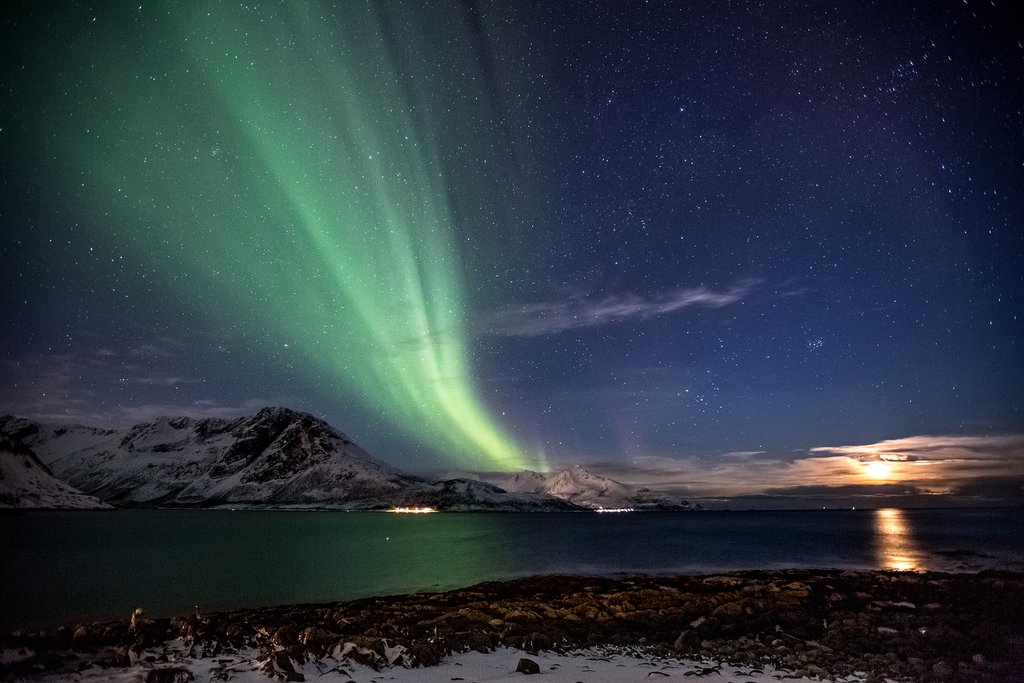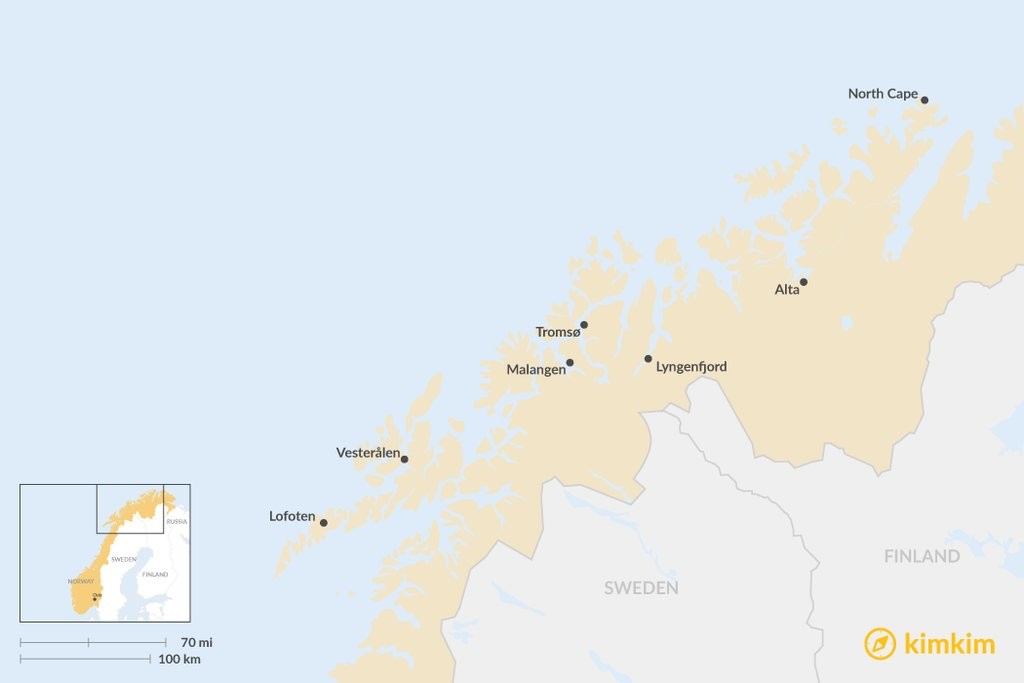Best Places to See the Northern Lights
Norway is a year-round destination, but the Northern Lights—perhaps its most magical attraction—can only be seen when all of Scandinavia is plunged into darkness. True, those long northern winters can seem daunting, but with a bit of planning and some weather-appropriate gear, you too could have an unforgettable encounter with the Aurora Borealis. Here's more on Norway weather in December, January, and February.
Lofoten

You’ve probably seen pictures of Lofoten, even if you don’t realize it. The achingly picturesque archipelago, scattered with colorful wooden cabins and quaint fishing boats against a backdrop of craggy peaks, sits in the middle of the Norwegian Sea above the Arctic Circle. Its location makes Lofoten the perfect place for viewing the Northern Lights as early as September or as late as April.
Trains run year-round from Stockholm and other destinations in Sweden, as well as Oslo and Trondheim in Norway, but the islands are so remote, you’ll have to catch either a bus, a speedboat or a ferry to make it all the way there (but the journey is incredibly scenic). There are also options to fly for travelers who are shorter on time.
Enjoy an unforgettable night in a traditional fisherman’s cabin called a rorbu, or visit the Lofotr Viking Museum to learn about the islands’ early inhabitants. What’s more, the islands are one of the world’s northernmost surfing hubs, and a handy jumping off point for hiking and horseback riding tours.
Vesterålen

Don’t call it Lofoten’s lesser-known sister archipelago, because this cluster of islands just to Lofoten’s north has a lot to offer all on their own. Chasing the Northern Lights in winter can often mean giving up a host of other activities that are only possible when the weather is warm. Not on Vesterålen, where you can spot humpback whales, sperm whales, and orcas even in winter, then enjoy a ski break in pristine mountains.
Vesterålen is serviced by the Hurtigruten as well as a year-round ferry service, and you can take a flight part of the way there (the nearest large airport is still 2 hours away in Narvik). Buses also connect larger cities in northern Norway to Sortland, Vesterålen’s largest town.
A number of cottages, cabins and rorbu homes welcome travelers in Vesterålen, offering simple but cozy accommodations in this remote part of the world. Aside from the popular Arctic safaris, a perfect chance to spot whales, seals and seabird colonies, you can take a trip to meet the nomadic Sami people—the only indigenous people on the European continent—learn about their culture and traditions, and even greet their reindeer.
North Cape

A rocky promontory ending in a cliff plunging down to the Barents Sea marks the North Cape or Nordkapp, the northernmost point in Norway, Scandinavia, and, give or take a few remote islands, Europe as well. Besides simply offering bragging rights for intrepid travelers, the North Cape is also an excellent center for winter activities, with ice fishing, ATV driving, dog-sledding snowshoeing, hiking and snowmobiling all on the menu for anyone daring enough to go this far.
Hitch a ride on the Hurtigruten to get to the North Cape, or take a flight to Honningsvåg, its closest airport. If you want to drive, however, you’ll experience an engineering marvel: a 700-ft deep undersea tunnel connects the island of Magarøya, where the North Cape is located, to the Norwegian mainland.
When you’re not out on a Northern Lights expedition, consider a visit to the Nordkapp Maritime Museum and the quaint Honningsvåg church, or keep cozy in a number of cabins, science centers and basecamps, all designed to get you up and close and personal with the aurora.
Chat with a local specialist who can help organize your trip.
Alta

Alta bills itself as the “City of the Northern Lights”, and it’s not hard to see why. Its remote location coupled with clear skies offer you the ideal conditions to spot the Aurora borealis. Scientists have been planning expeditions and building observatories here for over 100 years, starting with Kristian Birkeland, who put an observation center on top of Mt. Haldde in 1899.
Planes, trains, boats, and buses all run to Alta, but the best way to experience it may be in your own car or camper van, as you pass through on the way up to even more remote destinations like the North Cape.
After you’ve had your fill of the Northern Lights (if that’s even possible), make sure to stop by the Alta Museum—actually an outdoor rock art center with paths that wind among carvings between 2,000 and 6,200 years old. Another must-see is the stunning Northern Lights Cathedral. This contemporary building is the work of Stavanger’s Link architecture firm. Its innovative spiraling design is meant to mimic the dances of the Northern Lights as they twist and turn through the night sky.
Tromsø

Tromsø is certainly the most well-known of Norway’s Arctic cities, and for good reason: the largest city in Northern Norway, it actually feels like a bustling metropolis rather than a remote outpost. You’ll be spoiled for choice here, with a wide range of winter activities like whale-watching, dog sledding, and snow-shoeing along with cultural events, nightlife, and terrific restaurants. There are even multi-day dog sledding excursions for the adventurous—this itinerary is a great example.
With buses, ferries and several daily flights from Oslo, Tromsø is also the best connected of the Northern Lights viewing points. Of course, convenience comes at a price: a lot more travelers will be passing through here, so that may mean you’ll never feel the same sense of adventure and excitement some of the more hidden destinations can promise.
A wide range of accommodations welcome travelers to Tromsø, so you should have your pick from among traditional, budget, and luxury hotels, smaller guesthouses, and serviced apartments.
Lyngenfjord

Norway’s majestic fjords are a major draw in any season, but seeing them illuminated by the lights of the Aurora Borealis is a truly memorable experience. The 50-mile long Lyngenfjord is a stunning backdrop with its glaciers, ravines, and surrounding peaks, providing a perfect canvas for the Northern Lights to paint their otherworldly colors.
Buses run from Tromsø, home to the area’s closest major airport, and you can also travel over water, via the Hurtigruten (although it won't take you into the fjord itself) or express boat service. The best way to visit the fjord, however, may be to take a custom tour. These can include pickup from Tromsø, transportation, accommodation, and meals, as well as a plethora of activities like snowmobiling, skiing or ice-fishing.
Malangen

If you’re going to see one of nature’s most beautiful sights, why not do it in luxury? Malangen bills itself as the leading Northern Lights resort in the Tromsø region, built to accommodate discerning guests on a mission to chase down the Aurora borealis. With cabins built directly on the water, fine dining, and a spa and sauna with a glass front, it allows you to enjoy some serious wintry downtime when you’re not out in search of the lights, as well as organizing all aspects of your Northern Lights tour.
Malangen Resort offers transfers in winter from Tromsø airport (66km away) and Tromsø city center (71km away), so you can either disembark from your flight and head straight there, or spend a few days in the city before experiencing this gorgeous fjord retreat.
Planning Your Trip

Seasonality
Northern Lights season runs from late September to late March, when curtains of color dance across the sky, and the long winter nights and relatively fewer visitors mean you can enjoy this otherworldly experience at its peak.
Clothing
It goes without saying that you should dress warmly – the last thing you want is to have to duck inside to escape the cold the moment the light show gets going. Neck warmers, ski goggles, pant liners, and gloves inside of mittens will all do the trick in keeping you bundled up. Heat-trapping socks and battery-heated gloves are available for the truly hardcore. But don’t fret if you don’t have gear fit for an Arctic explorer: in most circumstances, normal winter clothing will also do the trick.
Photography
There’s no “correct” type or brand of camera for photographing the Northern Lights, but whichever you choose, make sure you know it well. Practice in manual mode and understand how to adjust the ISO and f-stop with the light. Chasing down the Northern Lights is about persistence and patience, so you won't want to find yourself struggling to capture that perfect image when the lights finally make their dramatic appearance. A tripod works wonders to steady the camera, and a remote control or automatic timer means you can snap images without even touching your device. Here are more photography tips for Norway.
Ready to plan a Northern Lights getaway? Check out these itineraries.
Northern Lights Road Trip - 7 Days. Traverse the Norwegian Arctic and check off a number of natural and cultural sites starting in the city of Tromsø. Learn about the indigenous Sami people in Karasjok, visit a snow hotel on the Finnish/Russian border, and end each day with another opportunity to view the Northern Lights.
Winter Adventure in Norway's Arctic - 10 Days. This epic trip through Norway's wintry north includes an array of activities unique to the Arctic. Each day presents another opportunity for great views and local culture. Snorkel with whales, dogsled with a team of huskies, and best of all, get multiple chances to see the Northern Lights—including on horseback.



